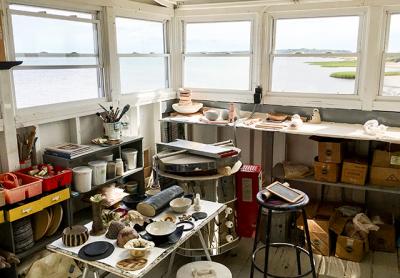The Art Barge: Artists in Their Element(s)

“It’s as far from 53rd Street as you can get,” Victor D’Amico once said about the Art Barge on Napeague Harbor, which he founded in 1963, most likely referring to the spiritual distance between the beached idyll for artists and midtown Manhattan’s Museum of Modern Art, where he served as director of education for over 30 years.
Standing on the sun-bleached deck of the isolated barge, officially known as the Victor D’Amico Institute of Art, facing the bay’s gentle silver ripples with the high rise of the ocean dunes looming behind, it feels even farther away today from the surrounding hype of a South Fork summer. In fact, it could easily top a list of the most un-Hamptons of places in the Hamptons.
Adding to the barge’s time-stands-still charm are its $200-a-week classes, taught from June through September by professional artists, usually offering 15 hours of instruction over five days. (That’s $40 for each three-hour lesson. For context, a private lesson at the nearby Napeague Tennis Club would set you back $150 for one hour. A lobster roll from the neighboring Lobster Roll restaurant costs $30.)
“I think they should be less,” said Christopher Kohan, speaking not of lobster rolls but of the classes. Mr. Kohan, president of the Art Barge, arrived on the East End in 1975, a recent college graduate with “a degree in whatever and looking for any job.” He took painting classes with Mr. D’Amico and was offered free accommodation in exchange for assisting older artists, carrying their easels, and doing odd jobs around the studio. Today, in addition to stewardship of the organization, Mr. Kohan is a devoted protector and historian of the Mabel and Victor D’Amico Studio and Archive, the couple’s Modernist-style cottage on Lazy Point, which they built during World War II and lived in until death: Victor in 1987 and Mabel in 1998.
One reason Mr. Kohan would like to minimize the cost of classes is to honor Mr. D’Amico’s credo of humanizing the arts — the democratizing power of a place where an East Hampton estate owner is working next to a Montauk fisherman, he explained.
“The effectiveness of art is to rediscover the dignity of man, to help man find his self-respect and to enjoy this greatest natural endowment, the power to create,” Mr. D’Amico wrote in the late ’60s. “In an era that has been brainwashed by science and has been idolized by the computer, man needs a new and respectable image.” Indeed, his thoughts seem even more relevant in today’s device-addled, dehumanized times.
The “power to create” at the Art Barge is offered through classes in a variety of media: pastel, watercolor, drawing, painting, collage, sculpture, ceramics, encaustic, printmaking, photography, and children’s workshops. Students are equally varied, a mix of locals, summer residents, transients, year-round weekenders, professionals, dabblers, and dreamers. Mr. Kohan noted a recent increase in international visitors; last year, he said, a family from Monaco came to paint.
From wherever they hail, one thing is constant: Disciples of the Art Barge speak of it as though it is a national treasure.
“Please don’t write an article about this place,” said Mallory May, an artist from New York City and Sag Harbor. “I don’t want anyone to discover it.” She discovered it last year when she took a painting class, and returned this summer for another in collage.
Her friend Katherine Fichthorne described the setting as “inspiring.” As for the cost of classes, an East End dinner for two “can cost more than $200.”
Then there are the “lifers,” as Mr. Kohan calls them, artists like Joyce Parcher and Judy Friedlander, both grandmothers who have been using the studio as a place to create for over 30 years. “Make that 100,” aid Ms. Friedlander, who leaves the East End for Florida each winter.
Mr. Kohan pointed to Ms. Parcher’s acrylic work-in-progress and said, “This is high-quality work. She’s a master with acrylic, and we’re just happy she comes here to do it.”
Mr. D’Amico never intended the barge to be a school, rather a facility that would bring artists into the elements, as close as possible to both land and water. Although loosely affiliated with MoMA, the nonprofit establishment is entirely self-funded, which means it has to find ways to stay afloat.
Revenue from classes covers the cost of instructors and art supplies. An annual fund-raiser helps toward maintenance of the 500-ton Navy barge, which was towed up the East River and into Napeague Harbor in 1960. But the very elements that Mr. D’Amico hoped would stimulate artists — sky, sea, and salt air — have taken their toll and left the almost 60-year-old structure “in need of a facelift,” said Mr. Kohan. He also dreams about having it winterized, but knows that such an extensive upgrade would require dedicated donors and believers.
In the South Fork’s ever-morphing landscape, where beloved landmarks are scooped up by developers and ransacked for profit, it is comforting to know that the Art Barge is protected by a zoning stipulation that it be used for educational purposes only. One hopes it will always remain just so, like time threaded through the eye of a needle, where one man’s dream continues to fulfill his expectation.
